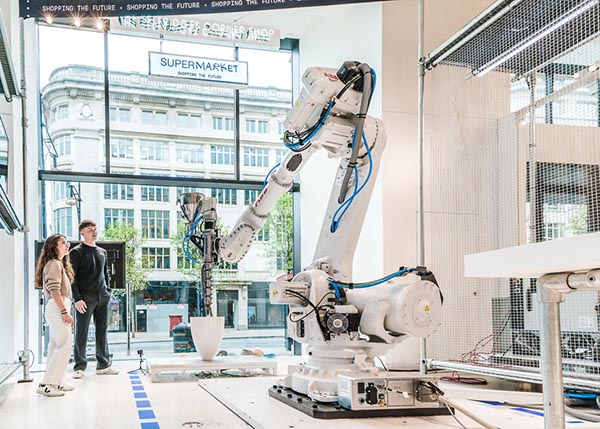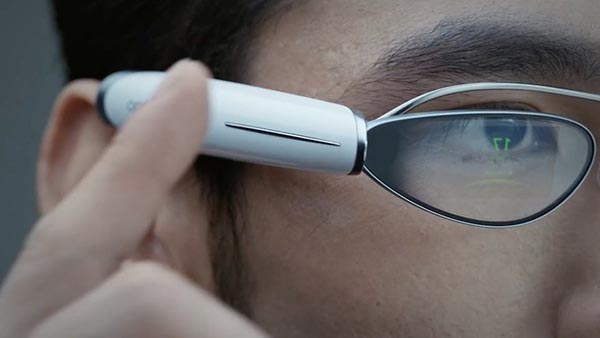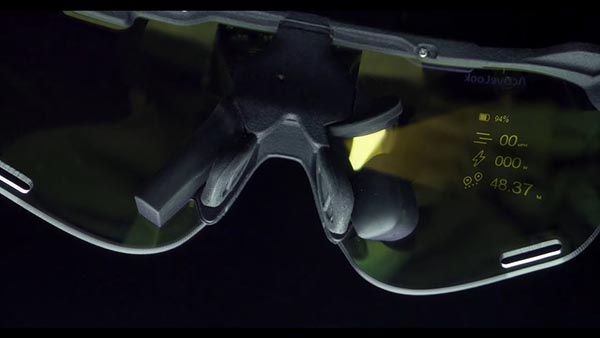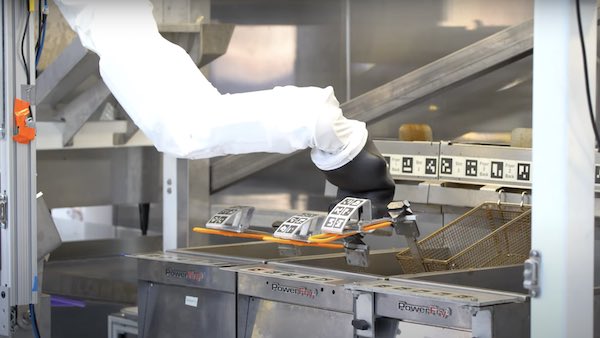Arms of Love
Here’s another great idea for taking an environmental scourge—namely, plastic from the oceans—and using it to make something useful. British retail chain Selfridges has launched a pop-up shop called SUPERMARKET, the centerpiece of which is a giant robotic arm that 3D prints consumer items on-demand using ocean-recovered plastic. Says Core77:
On display is a grouping of plastic waste recovered by Parley for the Oceans. Alongside them is the robot arm, printing out objects created by design brand Nagami, using Parley Ocean Plastic®. The customer is meant to fill in the blanks.
“By re-using plastic from the world’s oceans to print designer objects,” says ABB Robotics President Marc Segura, “we help to highlight the important contribution of robots in creating the sustainable manufacturing processes central to a circular economy.”

Disarming.
No Books Till Brooklyn
As book banning gains steam in parts of the country, the Brooklyn Public Library is fighting back, by offering free digital library cards to anyone in the US aged 13 to 21 which lets them access the BPL’s entire collection of ebooks. Says The Verge:
The initiative, called Books Unbanned, is fighting what the BPL describes as an “increasingly coordinated and effective effort to remove books tackling a wide range of topics from library shelves.” According to the American Library Association (ALA), a total of 729 books were challenged in 2021, meaning a person or group attempted to ban these titles from public libraries.
…In addition to the library cards offered to any people in the US between the ages of 13 and 21, the Brooklyn Public Library has also made a selection of ebooks and audiobooks that are frequently banned or challenged at other locations “always available” to library cardholders. You can see a full list of frequently challenged books (and why they were challenged) on the ALA’s website.
If you’re in the target age range, you can apply for your digital library card by emailing [email protected]. For more information, visit BPL’s website.
Rage Against the Packaging
In this space, we occasionally link to examples of packaging that is especially difficult to open. We recently came across a useful term, used to describe the elevated anger and frustration caused by the inability to open certain packaging: “wrap rage.”
A 2004 survey in Yours, a British magazine aimed at people over 50, found that 99% of the 2,000 respondents said packaging had become harder to open over the last 10 years, 97% said there was "too much excess packaging", and 60% said they had bought a product designed with more easily opened packaging.[10] In a survey conducted at the Cox School of Business, almost 80 percent of households "expressed anger, frustration or outright rage" with plastic packaging.[11] Consumers also tend to use words such as "hate" and "difficult" when describing these products.[12]
And it’s not just frustration: this stuff can be dangerous:
In the Yours survey, 71% of respondents said they had been injured while trying to open food packaging. The most common injury respondents had from trying to open packaging was "a cut finger, followed by a cut hand, sprained wrist, bruised hand and strained shoulder muscle."[10] According to a British study, over 60,000 people receive hospital treatment each year due to injuries from opening food packaging.[5] The Consumer Product Safety Commission estimated that attempts to open packaging caused about 6,500 emergency department visits in the U.S. in 2004.[13]
iWear
It’s a safe bet that the next big thing in display technology will be eyeglasses (contact lenses are likely after that), but the trick is how to actually get the data to appear on the display. Core77 identifies three basic approaches.
The first is Google Glass, which places a small screen distractingly over one of the lenses.

A better approach is used by OPPO Air Glass, which places a tiny projector on one of the eyeglass temples that then projects data onto the lens from the side.

An even better approach is used by Engo Eyewear, which puts a projector in the bridge between the lenses which then projects data onto one of the lenses.

There are many applications for a wearable eyewear display, but Engo in particular is targeting cyclists and runners, who like to see information like speed, time, heart rate, distance, elevation, power, or other stats while working out. Users can select which data points they want to see, and can toggle them using gesture controls on the side of the glasses.
Ultimately, whatever method eventually becomes standard will be whatever Apple comes up with, as they are almost certainly working on something like this.
Roosters Don’t Make Passes at Hens Who Wear Glasses
We don’t know if they project data, but believe it or not, there is such a thing as chicken eyeglasses. Via Boing Boing, chicken eyeglasses are indeed small spectacles for chickens designed to prevent feather pecking and cannibalism, which apparently is also a big problem. And if you think chickens have a fairly optimistic view of the world, maybe put it down to the rose-colored lenses that chicken eyeglasses often feature. The coloring masks the sight of blood on other chickens, which chicken (or other bird) experts think might be the cause of abnormal injurious behavior, often seen among birds.
Graphene Masks Pollution
Was it a good week for graphene news? It’s always a good week for graphene news! Graphene can help potentially solve what is probably going to be the next environmental scourge: discarded face masks. (Wanna bet that in about 10 years two-third of the Pacific Ocean is going to be a swirling gyre of discarded face masks and sanitary wipes?) As with any environmental scourge, the goal is to find a way to reuse stuff that would ordinarily be discarded. From Graphene-Info:
“These waste masks actually could be a valuable commodity if you process them properly,” said Xianming Shi, professor and interim chair of the Department of Civil and Environmental Engineering and the corresponding author on the paper. “I’m always looking out for waste streams, and my first reaction is ‘how do I turn that into something usable in concrete or asphalt?’”
Enter graphene.
A Washington State University (WSU) research team recently showed that used single-use masks, of the kind made ubiquitous in the pandemic, can be incorporated into a cement mixture (with the help of graphene oxide) to create stronger, more durable concrete. The team found that the mixture using mask materials was 47% stronger than commonly used cement after a month of curing.
They mixed the mask microfibers into a solution of graphene oxide before adding the mixture to cement paste. The graphene oxide provides ultrathin layers that strongly adhere to the fiber surfaces. Such mask microfibers absorb or dissipate the fracture energy that would contribute to tiny cracks in the concrete. Without the fibers, these microscopic cracks would eventually lead to wider cracks and the material’s failure.
John Deere Letter
Here at Around the Web, we are often skeptical about the practicality of much of what has come to be called “The Internet of Things,” but we’re happy to be wrong (on occasion). Case in point: foiling the Russians. Via CNN, Russian troops in the Ukrainian city of Melitopol stole all the farm equipment from a John Deere dealership and sent it 700 miles to Chechnya—only to find that it had been bricked.
The equipment ferried to Chechnya, which included combine harvesters – can also be controlled remotely. “When the invaders drove the stolen harvesters to Chechnya, they realized that they could not even turn them on, because the harvesters were locked remotely,” the contact said.
The equipment seems to be sitting on a farm near Grozny, as the folks who nicked it found consultants in Russia who are trying to unbrick it.
Sand in My Shoes…
Or maybe not. If it’s not one thing it’s another. On top of everything else going on in the world, now we face an impending sand crisis. Says Reuters:
Sand is the most exploited natural resource in the world after water, but its use is largely ungoverned, meaning we are consuming it faster than it can be replaced by geological processes that take hundreds of thousands of years, the U.N. Environment Programme (UNEP) report says.
Sand is used in glass, concrete, and other construction materials and its use has tripled over the past two decades to 50 billion tons a year—or about 17 kilograms per person each day. Our voracious consumption of sand is doing more than just tracking it through the house—it harms rivers and coastlines and is even eliminating small islands. There are all sorts of other problems as well: “In a Sri Lankan river, sand removal had reversed the water flow, meaning that ocean water was heading inland and bringing salt-water crocodiles with it, he told journalists.” Oops. So what is to be done?
Among the report's recommendations were a ban on beach extraction and the creation of an international standard for marine dredging that can harm ocean biodiversity.
It also called for reducing demand by reusing sand from recycled materials like concrete and mining tailings instead of using naturally occurring sand.
We’re sure everyone is going to get right on that.
Butcher Bots!
There’s a term to be reckoned with… The pandemic and then the subsequent Great Resignation/Reshuffling has driven a substantial increase in interest in automated food preparation and delivery. Gizmodo has an interesting slide show of some of the food tech that might be coming to an eatery near you.
Restaurants and food suppliers around the world are taking lessons learned from the pandemic and, in many cases, are adapting technologies to more permanent solutions. Cashierless checkout, online ordering, and QR codes all existed prior to the pandemic but were exposed to a much wider population of diners out of necessity.
Some highlights: Miso Robotics’ “Flippy,” a burger flipping robot that it claims is capable of serving around 300 burgers per day; Tyson’s autonomous “butcher robots” that automatically debone and butcher meat (at first…); and facial recognition bouncers and other systems for verifying age when patrons attempt to buy alcohol or tobacco. Some of this stuff is kind of creepy, but look for a lot of it to become the norm.

This Week in Printing, Publishing, and Media History
May 2
1519: Italian painter, sculptor, and architect Leonardo da Vinci dies (b. 1452).
1611: The King James Version of the Bible is published for the first time in London, England, by printer Robert Barker.
1885: American actress and gossip columnist Hedda Hopper born.
1895: American playwright and lyricist Lorenz Hart born.
1952: The world’s first ever jet airliner, the De Havilland Comet 1 makes its maiden flight, from London to Johannesburg. (Certain airlines are still using it...)
1955: Tennessee Williams wins the Pulitzer Prize for Drama for Cat on a Hot Tin Roof.
2000: Rand McNally’s national nightmare—President Bill Clinton announces that accurate GPS access would no longer be restricted to the United States military.
2012: A pastel version of The Scream, by Norwegian painter Edvard Munch, sells for $120 million in a New York City auction, setting a new world record for a work of art at auction.
May 3
1469: Italian historian and philosopher Niccolò Machiavelli born.
1913: Raja Harishchandra, the first full-length Indian feature film is released, marking the beginning of the Indian film industry.
1935: American businessman and founder of the Ronco Company Ron Popeil born. But wait! There’s more!
1952: The Kentucky Derby is televised nationally for the first time, on the CBS network.
1957: Walter O’Malley, the owner of the Brooklyn Dodgers, agrees to move the team from Brooklyn to Los Angeles.
1958: Danish-English comedian, author, and radio host Sandi Toksvig born.
1959: English actor, director, and screenwriter Ben Elton born.
1960: The Off-Broadway musical comedy The Fantasticks opens in New York City’s Greenwich Village, eventually becoming the longest-running musical of all time.
1965: Welsh actor and comedian Rob Brydon born.
1973: The 108-story Sears Tower (now officially the Willis Tower) in Chicago is topped out at 1,451 feet as the world's tallest building.
1978: The first unsolicited bulk commercial email (which would later become known as “spam”) is sent by a Digital Equipment Corporation marketing representative to every ARPANET address on the west coast of the United States.
May 4
1939: Israeli journalist and author Amos Oz born.
1953: Ernest Hemingway wins the Pulitzer Prize for The Old Man and the Sea.
1959: The 1st Grammy Awards are held.
1972: The Don't Make A Wave Committee, a fledgling environmental organization founded in Canada in 1971, officially changes its name to “Greenpeace Foundation.”
May 5
1809: Mary Kies becomes the first woman awarded a U.S. patent, for a technique of weaving straw with silk and thread.
1813: Danish philosopher and author Søren Kierkegaard, born.
1835: The first railway in continental Europe opens between Brussels and Mechelen.
1864: American journalist and author Nellie Bly born.
1866: Memorial Day first celebrated in United States at Waterloo, N.Y.
1891: The Music Hall in New York City (later known as Carnegie Hall) has its grand opening and first public performance, with Tchaikovsky as the guest conductor.
1905: The trial in the Stratton Brothers case begins in London, England; it marks the first time that fingerprint evidence is used to gain a conviction for murder.
1912: Pravda, the “voice” of the Communist Party of the Soviet Union, begins publication in Saint Petersburg.
1927: Semi-colon lovers’ national holiday—To the Lighthouse by Virginia Woolf is first published.
1943: English actor and screenwriter Michael Palin born.
1959: English singer-songwriter and guitarist Ian McCulloch born.
2001: American publisher, creator of CliffsNotes Clifton Hillegass dies (b. 1918).
2020: The National Telecommunications Commission issued a cease and desist order to ABS-CBN to stop the operations of its free TV and radio stations one day after their 25-year congressional franchise was expired.
May 6
1536: King Henry VIII orders English-language Bibles be placed in every church. In 1539 the Great Bible would be provided for this purpose.
1835: James Gordon Bennett, Sr. publishes the first issue of the New York Herald.
1840: The Penny Black postage stamp becomes valid for use in the United Kingdom of Great Britain and Ireland.
1862: American essayist, poet, and philosopher Henry David Thoreau dies (b. 1817).
1889: Typographer, known for work on Times New Roman font, Stanley Morison born.
1915: American actor, director, producer, and screenwriter Orson Welles born.
1940: John Steinbeck is awarded the Pulitzer Prize for his novel The Grapes of Wrath.
1949: EDSAC, the first practical electronic digital stored-program computer, runs its first operation.
1960: American singer-songwriter and guitarist (They Might Be Giants) John Flansburgh born.
May 7
1539: Italian printer Ottaviano Petrucci dies (b. 1466).
1711: Scottish economist, historian, and philosopher David Hume born.
1812: English poet and playwright Robert Browning born.
1824: World premiere of Ludwig van Beethoven’s Ninth Symphony in Vienna, Austria.
1840: Russian composer and educator Pyotr Ilyich Tchaikovsky born.
1846: The Cambridge Chronicle, America’s oldest surviving weekly newspaper, is published for the first time in Cambridge, Mass.
1952: The concept of the integrated circuit, the basis for all modern computers, is first published by Geoffrey Dummer.
May 8
1880: French novelist Gustave Flaubert dies (b. 1821).
1886: Pharmacist John Pemberton first sells a carbonated beverage named “Coca-Cola” as a patent medicine.
1912: Paramount Pictures is founded.
1920: American graphic designer and director Saul Bass born.
1926: English environmentalist and television host David Attenborough born.
1926: American comedian and actor Don Rickles born.
1937: American novelist Thomas Pynchon born.
1980: The World Health Organization confirms the eradication of smallpox. (Well, for now, anyway...)
1984: American publisher, co-founder of Reader’s Digest Lila Bell Wallace dies (b. 1890).
1985: American author and critic Theodore Sturgeon dies (b. 1918).
1988: American science fiction writer and screenwriter Robert A. Heinlein dies (b. 1907).










Discussion
Join the discussion Sign In or Become a Member, doing so is simple and free